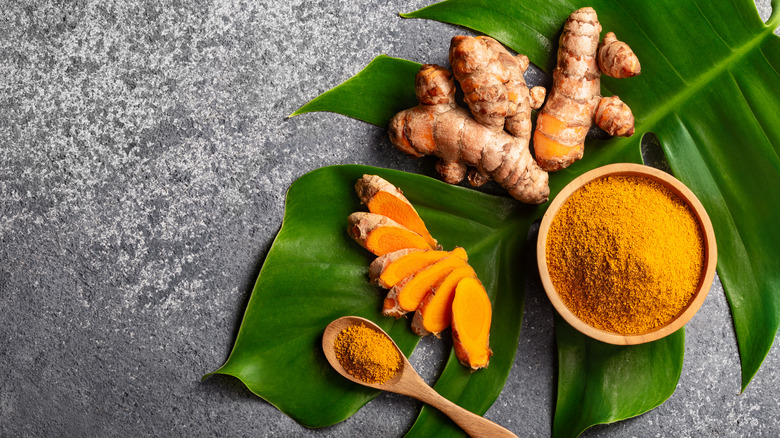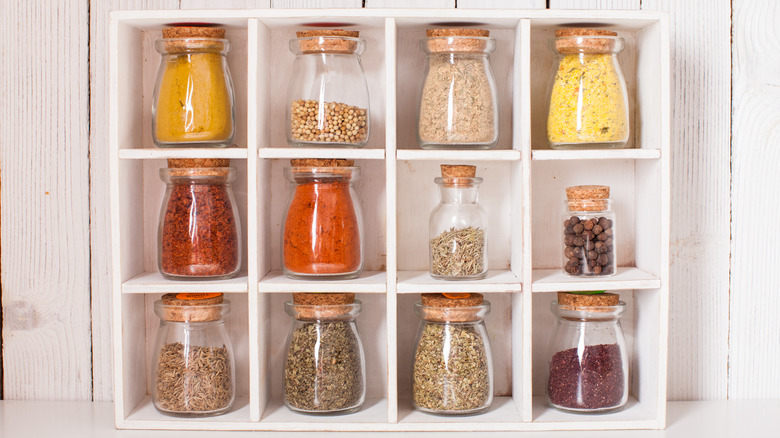The Difference Between Fresh And Dried Turmeric
According to the National Center for Complementary and Integrative Health (NIH), turmeric, or as it's known scientifically, Curcuma longa, is a plant that belongs to the Zingiberaceae family, along with many other common spices like cardamom, ginger, and arrowroot (via Britannica).
Native to Southeast Asia, and more particularly India, the plant is most famous as the culinary spice that gives curry powder its deep, yellow color. In many Native Indian cultures, turmeric's golden yellow to orange hues symbolized the sun, leading to beliefs in its spiritual and physical health benefits, per Ayurveda College.
Grown across India, from West Bengal to Maharashtra, historically, turmeric has been used in many of India's traditional medical systems, including Ayurveda, to treat a range of ailments (via NIH and Healthline). For this reason, you can find turmeric at stores worldwide, where it's typically sold in two forms: as the raw and fresh root or dried and ground into a powder. However, to get the most out of the spice, either in the culinary sense or the health sense, there are a few key differences you will want to note.
Nutritional differences
You can trace the source of turmeric's signature color and health benefits to one natural compound: curcumin. According to Healthline, it is the main active ingredient in turmeric. One 2015 study published by the National Library of Medicine found that curcumin has strong anti-oxidative and anti-inflammatory properties — making it useful in the prevention and treatment of many chronic diseases, including cancer, diabetes, psoriasis, and rheumatoid arthritis, among many others. Although fresh and dried turmeric contain curcumin, the bioavailability between the two is slightly different.
According to Vahdam, curcumin is best absorbed by the body when consuming fresh turmeric. But, while dried turmeric may not be as potent as fresh, there are several ways to improve its bioavailability. By simply adding a dash of black pepper along with your turmeric, dried or fresh, a 1998 study shows that you can increase its absorbency by 2000%. That's why you'll commonly find turmeric supplements containing piperine or pepper (via Healthline). Shaz & Kiks also points out that turmeric is fat-soluble, so by adding turmeric to foods that contain good fats, such as avocado or olive oil, your body can absorb it much more efficiently.
Shelf life
Turmeric is easy to store, whether dried or fresh, but each shelf life is not quite as straightforward. According to Vahdam, dried turmeric can last for years in your spice cabinet if stored in an airtight container and away from light. Like any other dry seasoning that's been sitting in your cupboard for who knows how long, that much is easy to understand. So, it may not come as a surprise that the shelf life of fresh turmeric can't compare to dried.
You can store fresh turmeric root in your refrigerator for about two weeks (via Caitey Jay). And to get that type of life span out of your fresh turmeric, you'll have to put in a bit of effort to ensure it stays dry. After you've cleaned it, it's important to pat the turmeric root dry with a paper towel and store it in a paper bag to prevent molding. However, if you reach that two-week mark and you still haven't used all of your turmeric, it will also last in your freezer for up to six months.
How to cook with each
Although dried and fresh turmeric has many of the same properties, they do differ in some ways when it comes to cooking — the primary difference being their taste. While fresh turmeric is more vibrant and robust in flavor, dried turmeric is much more subdued (via Vahdam). Still, dried turmeric tends to be used more often simply because it's much more convenient and won't overpower your food.
Dried turmeric is a seasoning you can grab and sprinkle on almost anything. But that doesn't mean fresh turmeric doesn't have its moments where it comes out on top. In the case of fresh juices, smoothies, golden milk lattes, or tea, fresh turmeric is almost always favored for the spicey flavor it brings — and peeling the skin is optional, as long as you've cleaned it.
Anna Stockwell, the senior food editor at Epicurious, particularly enjoys grating, mincing, or pounding fresh turmeric into a paste and incorporating it into her soups. You could even take the fresh turmeric paste and freeze it in an ice cube tray for a quicker option.
Recipe swapping
Seeing as dried and fresh turmeric are different forms of the same ingredient, they're often used interchangeably in the kitchen. To do so, however, the quantities need to be adjusted slightly. According to Vahdam, should you ever want to substitute fresh turmeric for dry, you'll need to use three times as much. There are certain instances, however, where this may not be recommended.
For example, because fresh turmeric maintains the plant oils, it turns into a paste when minced or ground. This makes it rather useless in dishes or recipes that require a dry rub. Also, generally speaking, fresh turmeric is best for raw foods and drinks, while dried is best for cooked dishes (via America's Test Kitchen), such as crispy buttered turmeric rice. However, fresh turmeric can be used in cooked dishes, too — particularly ones that could benefit from its bright, gingery flavor.
On the other hand, you can substitute dried turmeric for fresh in almost all circumstances — just keep in mind that you won't get the same flavor intensity. To do so, Swirls of Flavor recommends using one teaspoon of powder for every inch of turmeric root you'd use.




